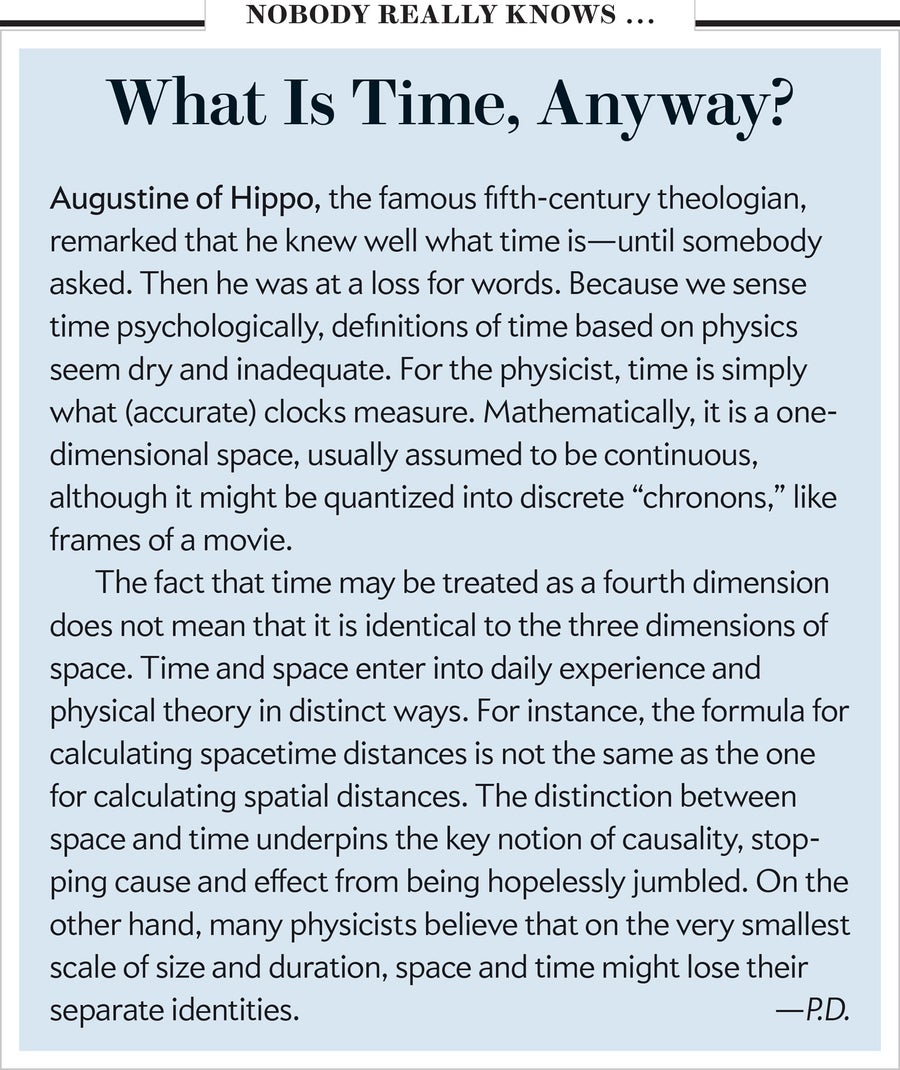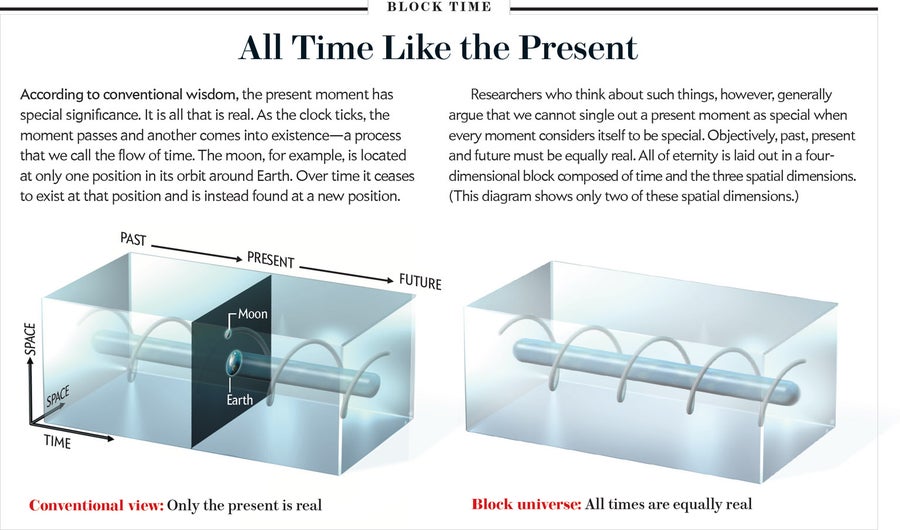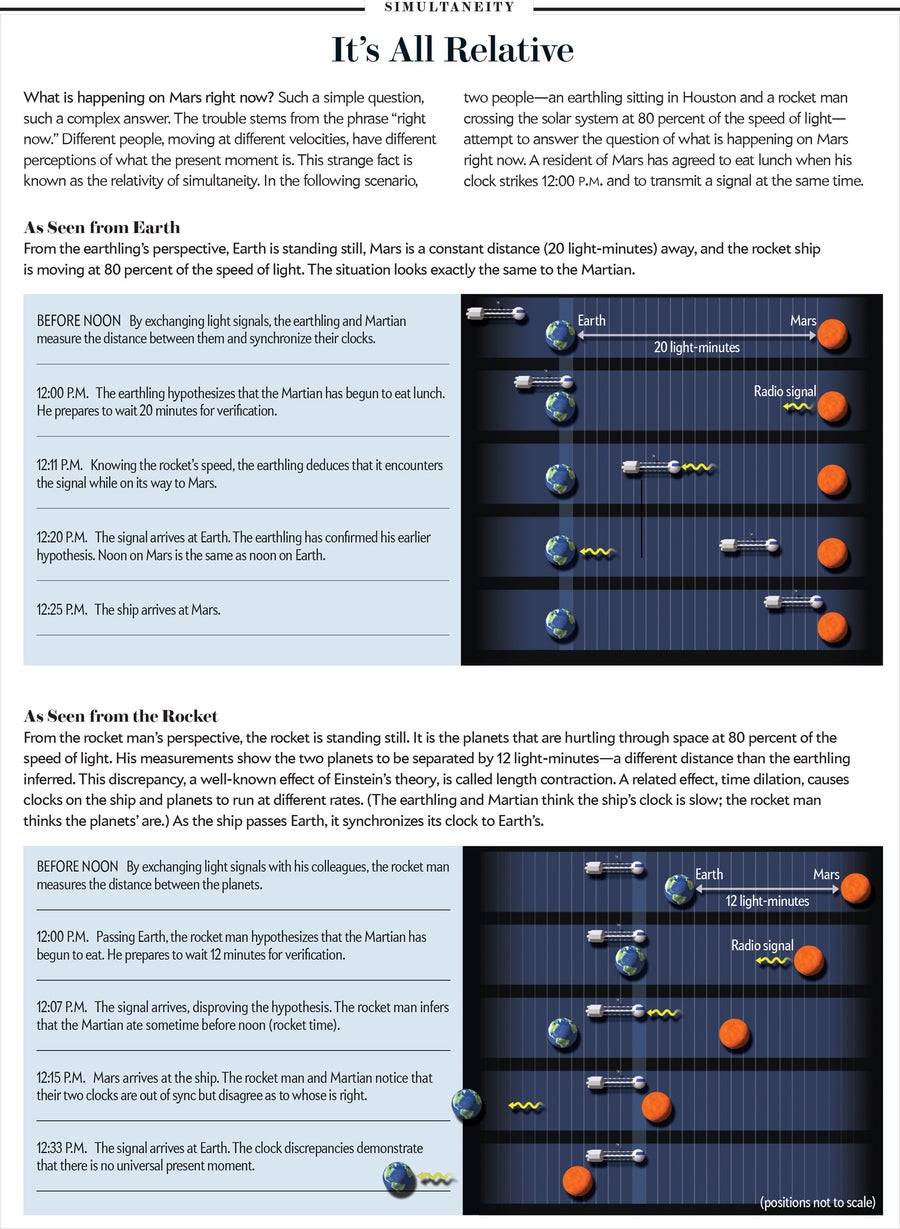Gather ye rosebuds while ye may,/old time is still a-flying.” So wrote 17th-century English poet Robert Herrick, capturing the universal cliché that time flies. And who could doubt that it does? The passage of time is probably the most basic facet of human perception, for we feel time slipping by in our innermost selves in a manner that is altogether more intimate than our experience of, say, space or mass. The passage of time has been compared to the flight of an arrow and to an ever rolling stream, bearing us inexorably from past to future. Shakespeare wrote of “the whirligig of time,” his countryman Andrew Marvell of “Time's winged chariot hurrying near.”
Evocative though these images may be, they run afoul of a deep and devastating paradox. Nothing in known physics corresponds to the passage of time. Indeed, physicists insist that time doesn't flow at all; it merely is. Some philosophers argue that the very notion of the passage of time is nonsensical and that talk of the river or flux of time is founded on a misconception. How can something so basic to our experience of the physical world turn out to be a case of mistaken identity? Or is there a key quality of time that science has not yet identified?
Time Isn't of the Essence
On supporting science journalism
If you're enjoying this article, consider supporting our award-winning journalism by subscribing. By purchasing a subscription you are helping to ensure the future of impactful stories about the discoveries and ideas shaping our world today.
In daily life we divide time into three parts: past, present and future. The grammatical structure of language revolves around this fundamental distinction. Reality is associated with the present moment. The past we think of as having slipped out of existence, whereas the future is even more shadowy, its details still unformed. In this simple picture, the “now” of our conscious awareness glides steadily onward, transforming events that were once in the unformed future into the concrete but fleeting reality of the present—and thence relegating them to the fixed past.
Obvious though this commonsense description may seem, it is seriously at odds with modern physics. Albert Einstein famously expressed this point when he wrote to a friend, “The past, present and future are only illusions, even if stubborn ones.” Einstein's startling conclusion stems directly from his special theory of relativity, which denies any absolute, universal significance to the present moment. According to the theory, simultaneity is relative. Two events that occur at the same moment if observed from one reference frame may occur at different moments if viewed from another.
An innocuous question such as “What is happening on Mars now?” has no definite answer. The key point is that Earth and Mars are a long way apart—up to about 20 light-minutes. Because information cannot travel faster than light, an Earth-based observer is unable to know the situation on Mars at the same instant. He must infer the answer after the event, when light has had a chance to pass between the planets. The inferred past event will be different depending on the observer's velocity.
For example, during a future manned expedition to Mars, mission controllers back on Earth might say, “I wonder what Commander Jones is doing at Alpha Base now.” Looking at their clock and seeing that it was 12:00 P.M. on Mars, their answer might be “eating lunch.” But an astronaut zooming past Earth at near the speed of light at the same moment could, on looking at his clock, say that the time on Mars was earlier or later than 12:00 P.M., depending on his direction of motion. That astronaut's answer to the question about Commander Jones's activities would be “cooking lunch” or “washing dishes” [see "It's All Relative" graphic, below]. Such mismatches make a mockery of any attempt to confer special status on the present moment, for whose “now” does that moment refer to? If you and I were in relative motion, an event that I might judge to be in the as yet undecided future might for you already exist in the fixed past.
The most straightforward conclusion is that both past and future are fixed. For this reason, physicists prefer to think of time as laid out in its entirety—a timescape, analogous to a landscape—with all past and future events located there together. It is a notion sometimes referred to as block time. Completely absent from this description of nature is anything that singles out a privileged, special moment as the present or any process that would systematically turn future events into present, then past, events. In short, the time of the physicist does not pass or flow.
How Time Doesn't Fly
A number of philosophers over the years have arrived at the same conclusion by examining what we normally mean by the passage of time. They argue that the notion is internally inconsistent. The concept of flux, after all, refers to motion. It makes sense to talk about the movement of a physical object, such as an arrow through space, by gauging how its location varies with time. But what meaning can be attached to the movement of time itself? Relative to what does it move? Whereas other types of motion relate one physical process to another, the putative flow of time relates time to itself. Posing the simple question “How fast does time pass?” exposes the absurdity of the very idea. The trivial answer “one second per second” tells us nothing at all.


Credit: Bryan Christie Design
Although we find it convenient to refer to time's passage in everyday affairs, the notion imparts no new information that cannot be conveyed without it. Consider the following scenario: Alice was hoping for a white Christmas, but when the day came she was disappointed that it only rained; however, she was happy that it snowed the following day. Although this description is replete with tenses and references to time's passage, exactly the same information is conveyed by simply correlating Alice's mental states with dates, in a manner that omits all reference to time passing or the world changing. Thus, the following cumbersome and rather dry catalogue of facts suffices:
December 24: Alice hopes for a white Christmas.
December 25: There is rain. Alice is disappointed.
December 26: There is snow. Alice is happy.
In this description, nothing happens or changes. There are simply states of the world at different dates and associated mental states for Alice.
Similar arguments go back to ancient Greek philosophers such as Parmenides and Zeno. A century ago British philosopher John McTaggart sought to draw a clear distinction between the description of the world in terms of events happening, which he called the A series, and the description in terms of dates correlated with states of the world, the B series. Each appears to be a true description of reality, and yet the two points of view are seemingly in contradiction. For example, the event “Alice is disappointed” was once in the future, then in the present and afterward in the past. But past, present and future are exclusive categories, so how can a single event have the character of belonging to all three? McTaggart used this clash between the A and B series to argue for the unreality of time as such, perhaps a rather drastic conclusion. Most physicists would put it less dramatically: the flow of time is unreal, but time itself is as real as space.
Just in Time
A great source of confusion in discussions of time's passage stems from its link with the so-called arrow of time. To deny that time flows is not to claim that the designations “past” and “future” are without physical basis. Events in the world undeniably form a unidirectional sequence. For instance, an egg dropped on the floor will smash into pieces, whereas the reverse process—a broken egg spontaneously assembling itself into an intact egg—is never witnessed. This is an example of the second law of thermodynamics, which states that the entropy of a closed system—roughly defined as how disordered it is—will tend to rise with time. An intact egg has lower entropy than a shattered one.
Because nature abounds with irreversible physical processes, the second law of thermodynamics plays a key role in imprinting on the world a conspicuous asymmetry between past and future directions along the time axis. By convention, the arrow of time points toward the future. This does not imply, however, that the arrow is moving toward the future, any more than a compass needle pointing north indicates that the compass is traveling north. Both arrows symbolize an asymmetry, not a movement. The arrow of time denotes an asymmetry of the world in time, not an asymmetry or flux of time. The labels “past” and “future” may legitimately be applied to temporal directions, just as “up” and “down” may be applied to spatial directions, but talk of the past or the future is as meaningless as referring to the up or the down.

Credit: Bryan Christie Design
The distinction between pastness or futureness and “the” past or “the” future is graphically illustrated by imagining a movie of, say, the egg being dropped on the floor and breaking. If the film were run backward through the projector, everyone would see that the sequence was unreal. Now imagine if the film strip were cut up into frames and the frames shuffled randomly. It would be a straightforward task for someone to rearrange the stack of frames into a correctly ordered sequence, with the broken egg at the top of the stack and the intact egg at the bottom. This vertical stack retains the asymmetry implied by the arrow of time because it forms an ordered sequence in vertical space, proving that time's asymmetry is actually a property of states of the world, not a property of time as such. It is not necessary for the film to actually be run as a movie for the arrow of time to be discerned.
Given that most physical and philosophical analyses of time fail to uncover any sign of a temporal flow, we are left with something of a mystery. To what should we attribute the powerful, universal impression that the world is in a continual state of flux? Some researchers, notably the late Nobel laureate chemist Ilya Prigogine, have contended that the subtle physics of irreversible processes make the flow of time an objective aspect of the world. But I and others argue that it is some sort of illusion.
After all, we do not really observe the passage of time. What we actually observe is that later states of the world differ from earlier states that we still remember. The fact that we remember the past, rather than the future, is an observation not of the passage of time but of the asymmetry of time. Nothing other than a conscious observer registers the flow of time. A clock measures durations between events much as a measuring tape measures distances between places; it does not measure the “speed” with which one moment succeeds another. Therefore, it appears that the flow of time is subjective, not objective.
Living in the Present
This illusion cries out for explanation, and that explanation is to be sought in psychology, neurophysiology, and maybe linguistics or culture. Modern science has barely begun to consider the question of how we perceive the passage of time; we can only speculate about the answer. It might have something to do with the functioning of the brain. If you spin around several times and stop suddenly, you will feel giddy. Subjectively, it seems as if the world is rotating relative to you, but the evidence of your eyes is clear enough: it is not. The apparent movement of your surroundings is an illusion created by the rotation of fluid in the inner ear. Perhaps temporal flux is similar.
There are two aspects to time asymmetry that might create the false impression that time is flowing. The first is the thermodynamic distinction between past and future. As physicists have realized over the past few decades, the concept of entropy is closely related to the information content of a system. For this reason, the formation of memory is a unidirectional process—new memories add information and raise the entropy of the brain. We might perceive this unidirectionality as the flow of time.
A second possibility is that our perception of the flow of time is linked in some way to quantum mechanics. It was appreciated from the earliest days of the formulation of quantum mechanics that time enters into the theory in a unique manner, quite unlike space. The special role of time is one reason it is proving so difficult to merge quantum mechanics with general relativity. The Heisenberg uncertainty principle, according to which nature is inherently indeterministic, implies an open future (and, for that matter, an open past). This indeterminism manifests itself most conspicuously on an atomic scale of size and dictates that the observable properties that characterize a physical system are generally undecided from one moment to the next.
For example, an electron hitting an atom may bounce off in one of many directions, and it is normally impossible to predict in advance what the outcome in any given case will be. Quantum indeterminism implies that for a particular quantum state there are many (possibly infinite) alternative futures or potential realities. Quantum mechanics supplies the relative probabilities for each observable outcome, although it won't say which potential future is destined for reality.
But when a human observer makes a measurement, one and only one result is obtained; for example, the rebounding electron will be found moving in a certain direction. In the act of measurement, a single, specific reality gets projected out from a vast array of possibilities. Within the observer's mind, the possible makes a transition to the actual, the open future to the fixed past—which is precisely what we mean by the flux of time.
There is no agreement among physicists on how this transition from many potential realities into a single actuality takes place. Many physicists have argued that it has something to do with the consciousness of the observer, on the basis that it is the act of observation that prompts nature to make up its mind. A few researchers, such as Roger Penrose of the University of Oxford, maintain that consciousness—including the impression of temporal flux—could be related to quantum processes that take place in the brain.
Although researchers have failed to find evidence for a single “time organ” in the brain, in the manner of, say, the visual cortex, it may be that future work will pin down those brain processes responsible for our sense of temporal passage. It is possible to imagine drugs that could suspend the subject's impression that time is passing. Indeed, some practitioners of meditation claim to be able to achieve such mental states naturally.
And what if science were able to explain away the flow of time? Perhaps we would no longer fret about the future or grieve for the past. Worries about death might become as irrelevant as worries about birth. Expectation and nostalgia might cease to be part of human vocabulary. Above all, the sense of urgency that attaches to so much of human activity might evaporate. No longer would we be slaves to Henry Wadsworth Longfellow's entreaty to “act, act in the living present,” for the past, present and future would literally be things of the past.

